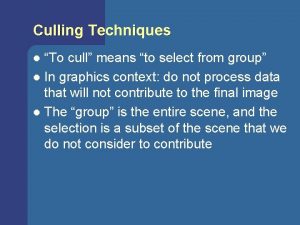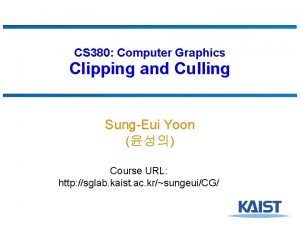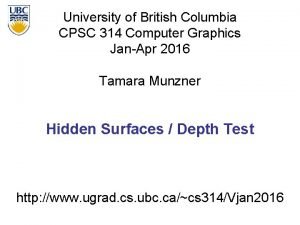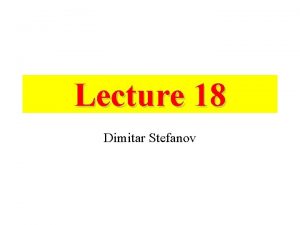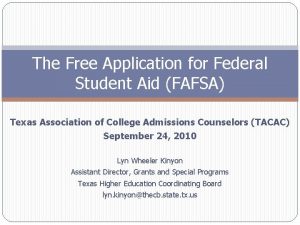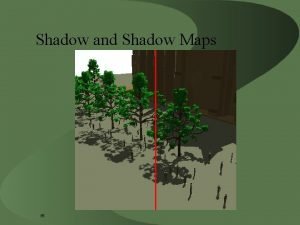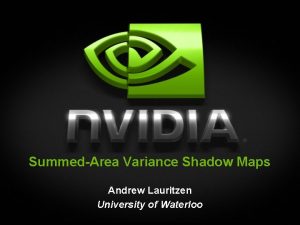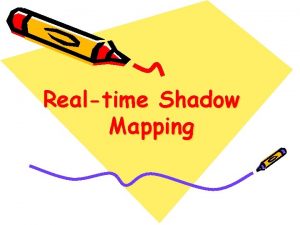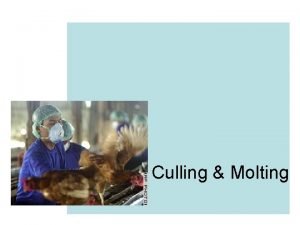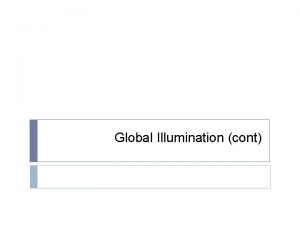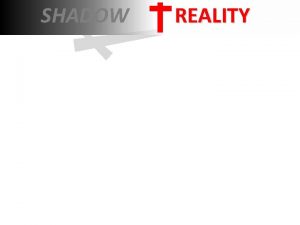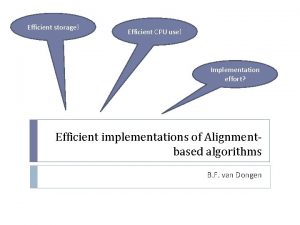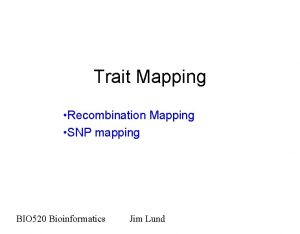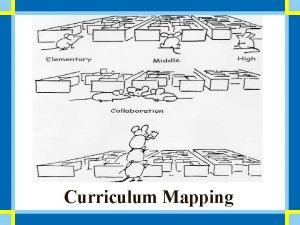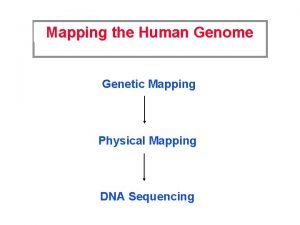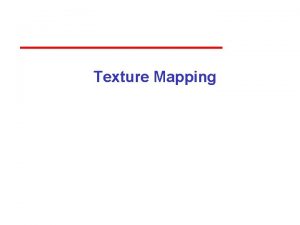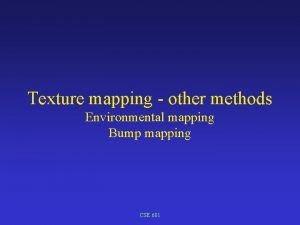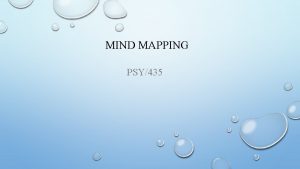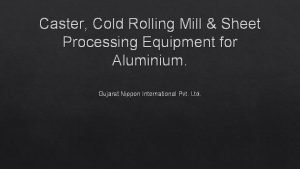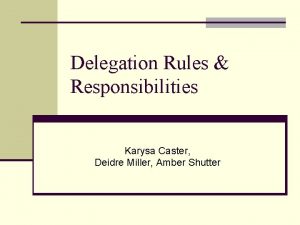SHADOW CASTER CULLING FOR EFFICIENT SHADOW MAPPING JI

















![Walkthrough Summary Results Average frame times [ms] I 3 D 2011 (18) Walkthrough Summary Results Average frame times [ms] I 3 D 2011 (18)](https://slidetodoc.com/presentation_image/1115c5719d4ffde4ce284ae9a54938a7/image-18.jpg)






- Slides: 24

SHADOW CASTER CULLING FOR EFFICIENT SHADOW MAPPING JIŘÍ BITTNER 1 OLIVER MATTAUSCH 2 ARI SILVENNOINEN 3 MICHAEL WIMMER 2 1 CZECH TECHNICAL UNIVERSITY IN PRAGUE 2 VIENNA UNIVERSITY OF TECHNOLOGY 3 UMBRA SOFTWARE

Shadow Caster Culling - Motivation Light view Camera view Occlusion culling View frustum culling 100 10 FPS I 3 D 2011 View Occlusion frustum culling 109 FPS 100 FPS 8 FPS 50 FPS 9 Total 5 (2)

Previous Work § Culling shadow casters for shadow volumes – Shadow caster culling [Govindaraju et al. 2003] – CC Shadow Volumes [Lloyd et al. 2004] – N-Buffers [Decoret 2005] – And others… [Eisenmann&Decoret 2006], [Engelhardt&Dachsbacher 2009] § Common to all methods – Shadow map as a proxy (not a bottleneck) – No culling or simple culling for shadow map – Analyze the map (cull shadow casters) & render shadow volumes § Shadow mapping – Higher rendering efficiency than shadow volumes – Bottleneck moves to shadow map rendering I 3 D 2011 (3)

Shadow Caster Culling - Overview 1. Render camera view – Occlusion culling, CHC++ [Mattausch et al. 2008] – Depth map + visible objects 2. Create receiver mask – Information about visible objects/pixels from camera to light view – Stencil buffer 3. Render shadow map – Occlusion queries with stencil test 4. Do shading – Use shadow map(s) to illuminate camera view more lights I 3 D 2011 (4)

Shadow Receiver Mask § Different ways how to create a receiver mask – Mask construction cost vs accuracy (culling effciency) § Proposed techniques – Bounding volume mask (BVOL) – Geometry mask (GEOM) – Combined bounding volume & geometry mask – Fragment mask (FRAG) I 3 D 2011 (5)

Bounding Volume Mask § Bounding boxes of visible objects to stencil buffer Fast to render + § Conservative § I 3 D 2011 (6)

Geometry Mask § Geometry of visible objects to stencil buffer More accurate + § Possibly slow § – Fill rate increase (rendering geometry of shadowed receivers) I 3 D 2011 (7)

Bounding Volume + Geometry Mask § Geometry for visible objects (from light) Bounding volumes for invisible objects (from light) § Use temporal coherence § – Predict object visibility based on last frame visibility § Accurate as geometry + Faster than geometry + I 3 D 2011 (8)

Fragment Mask § Test visibility of fragments in camera view – “Shadow test” with respect to camera depth map – [Lloyd et al. 2004], [Decoret 2005] § Pixel accurate mask + I 3 D 2011 Slower construction - (9)

Masks Efficiency Example Culled D, C, B I 3 D 2011 (10)

Masks Efficiency Example I 3 D 2011 (11)

Additional Techniques § Visibility-based focusing § Incremental updates for dynamic scenes I 3 D 2011 (12)

Visibility-based focusing Focus light frustum on intersection of view frustum + convex hull of visible objects + Speedup, better use of resolution - Temporal aliasing § Similar to [Lauritzen et al. 2010] § Frame 3 4 2 1 I 3 D 2011 (13)

Incremental Updates for Dynamic Scenes § Until now we allowed – Dynamic scenes – Dynamic shadows Assume static shadow map → Further optimization possible! § Update only necessary part of shadow map § Construct mask only from visible dynamic objects § – Previous and new position – Clear depth buffer + write stencil (mask) I 3 D 2011 (14)

Results Vienna 12 M vert. § Manhattan 105 M vert. Pompeii 63 M vert. Left 4 Death 2 1, 5 M vert. Reference methods – VFC - view frustum culling (camera + light) – REF - CHC++ occlusion culling (camera + light) – FOCUS - REF + visibility-aware focusing Uniform/Light space perspective shadow maps (Li. SPSM) § Intel Core i 7 -920 2. 67 GHz + Ge. Force 480 GTX § I 3 D 2011 (15)

Walkthrough Timings I 3 D 2011 (16)

Walkthrough Timings I 3 D 2011 (17)
![Walkthrough Summary Results Average frame times ms I 3 D 2011 18 Walkthrough Summary Results Average frame times [ms] I 3 D 2011 (18)](https://slidetodoc.com/presentation_image/1115c5719d4ffde4ce284ae9a54938a7/image-18.jpg)
Walkthrough Summary Results Average frame times [ms] I 3 D 2011 (18)

Different Masking Techniques I 3 D 2011 (19)

Incremental Updates I 3 D 2011 UNSHAD – no shadow mapping (20)

Light Elevation Angle I 3 D 2011 (21)

Conclusion & Future Work § Efficient shadow map rendering method – Shadow receiver mask – Mask culling + occlusion culling (using extended CHC++ algorithm) – Different masks – Incremental updates § Results – 3 -10 x faster than traditional culling for large city scenes – 1. 5 -2 x faster for game scene – Implemented inside visibility middleware (Umbra Software) § Future Work – More light sources – Incremental updates for moving lights I 3 D 2011 (22)

… thank you bittner@fel. cvut. cz

… thank you bittner@fel. cvut. cz
 Allocative efficiency
Allocative efficiency Productively efficient vs allocatively efficient
Productively efficient vs allocatively efficient Allocative efficiency vs productive efficiency
Allocative efficiency vs productive efficiency Productively efficient vs allocatively efficient
Productively efficient vs allocatively efficient Allocative efficiency vs productive efficiency
Allocative efficiency vs productive efficiency Portal culling
Portal culling Bgp culling
Bgp culling Culling techniques
Culling techniques Occulusion culling
Occulusion culling Clipping and culling
Clipping and culling Bfnffn
Bfnffn Caster flutter
Caster flutter Mokgadi caster
Mokgadi caster Wheel alignment angles
Wheel alignment angles Fafsa caster
Fafsa caster Fafsa caster
Fafsa caster Shadow map bias
Shadow map bias Perspective shadow map
Perspective shadow map Variance shadow mapping
Variance shadow mapping Variance shadow mapping
Variance shadow mapping The associative mapping is costlier than direct mapping.
The associative mapping is costlier than direct mapping. Forward mapping vs backward mapping
Forward mapping vs backward mapping Terjemahan
Terjemahan Claes martinsson
Claes martinsson Sju principer för tillitsbaserad styrning
Sju principer för tillitsbaserad styrning







